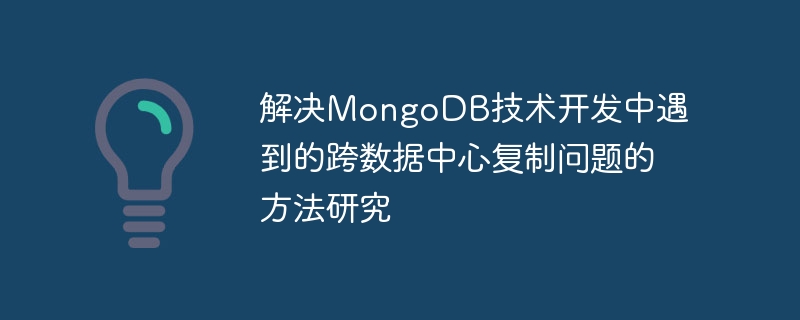
Research on methods to solve cross-data center replication problems encountered in MongoDB technology development requires specific code examples
In the modern information age, the distribution and distribution of data Replication has become an important issue that cannot be ignored in database development. MongoDB, a popular NoSQL database, also faces cross-data center replication challenges when applications require data replication between different data centers. This article will explore ways to solve MongoDB's cross-datacenter replication issues and provide some concrete code examples.
1. Overview of the replication process
Cross-data center replication refers to copying data from one data center to another to achieve data availability and redundant backup. MongoDB uses replica set (Replica Set) technology to achieve data replication and automatic failure recovery. A replica set consists of multiple MongoDB instances, including a primary node and other nodes as replica nodes (Secondary). When the primary node is no longer available or fails, the system automatically elects a new primary node from the replica nodes.
2. Problems with cross-data center replication
However, cross-data center replication will face some challenges and problems:
3. Research on solutions
In order to solve the problem of cross-data center replication, we can take the following methods:
4. Specific code examples
The following is a sample code that uses the Java MongoDB driver to implement cross-data center replication:
public class MongoDBReplicationExample {
public static void main(String[] args) {
MongoClient primaryClient = new MongoClient("primary data center");
MongoClient secondaryClient = new MongoClient("secondary data center");
MongoDatabase primaryDB = primaryClient.getDatabase("test");
MongoDatabase secondaryDB = secondaryClient.getDatabase("test");
// 创建一个复制集
ReplicaSetConfig config = new ReplicaSetConfig(
Arrays.asList(
new ServerAddress("primary data center"),
new ServerAddress("secondary data center1"),
new ServerAddress("secondary data center2")
),
"myReplicaSet"
);
MongoReplicaSetClient replicaSetClient = new MongoReplicaSetClient(config);
MongoDatabase replicaSetDB = replicaSetClient.getDatabase("test");
// 确保复制集初始化完成
replicaSetDB.runCommand(new Document("replSetInitiate", ""));
// 向主节点插入数据
primaryDB.getCollection("myCollection").insertOne(new Document("name", "foo"));
// 等待数据复制到副本节点
while (secondaryDB.getCollection("myCollection").count() == 0) {
try {
Thread.sleep(1000);
} catch (InterruptedException e) {
e.printStackTrace();
}
}
// 在副本节点查询数据
FindIterable<Document> documents = secondaryDB.getCollection("myCollection").find();
for (Document document : documents) {
System.out.println(document);
}
// 关闭连接
primaryClient.close();
secondaryClient.close();
replicaSetClient.close();
}
}In the above sample code, we Create a replica set of one primary node and two replica nodes, insert a piece of data to the primary node, then wait for the data to be copied to the replica node, and query the data on the replica node.
5. Summary
This article explores ways to solve the problem of cross-data center replication in MongoDB technology development, and provides some specific code examples. Cross-data center replication is a complex problem and requires choosing a suitable solution based on the actual situation. By rationally selecting data centers and introducing Oplog management and conflict resolution strategies, we can achieve efficient replication and data consistency across data centers. At the same time, we also show sample code for using the Java MongoDB driver to implement cross-data center replication, which we hope will be helpful to readers.
The above is the detailed content of Research on methods to solve cross-data center replication problems encountered in MongoDB technology development. For more information, please follow other related articles on the PHP Chinese website!
 The difference between mongodb and mysql
The difference between mongodb and mysql
 mongodb startup command
mongodb startup command
 How to delete data in MongoDB
How to delete data in MongoDB
 Commonly used database software
Commonly used database software
 What are the application areas of mongodb?
What are the application areas of mongodb?
 Which one has faster reading speed, mongodb or redis?
Which one has faster reading speed, mongodb or redis?
 How to completely delete mongodb if the installation fails
How to completely delete mongodb if the installation fails
 Mongodb and mysql are easy to use and recommended
Mongodb and mysql are easy to use and recommended




